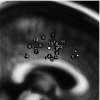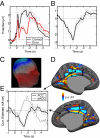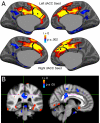Multimodal neuroimaging dissociates hemodynamic and electrophysiological correlates of error processing
- PMID: 21969565
- PMCID: PMC3198335
- DOI: 10.1073/pnas.1103475108
Multimodal neuroimaging dissociates hemodynamic and electrophysiological correlates of error processing
Abstract
Recognizing errors and adjusting responses are fundamental to adaptive behavior. The error-related negativity (ERN) and error-related functional MRI (fMRI) activation of the dorsal anterior cingulate cortex (dACC) index these processes and are thought to reflect the same neural mechanism. In the present study, we evaluated this hypothesis. Although errors elicited robust dACC activation using fMRI, combined electroencephalography and magnetoencephalography data localized the ERN to the posterior cingulate cortex (PCC). ERN amplitude correlated with fMRI activation in both the PCC and dACC, and these two regions showed coordinated activity based on functional connectivity MRI. Finally, increased microstructural integrity of the posterior cingulum bundle, as measured by diffusion tensor imaging, predicted faster error correction. These findings suggest that the PCC generates the ERN and communicates with the dACC to subserve error processing. They challenge current models that view fMRI activation of the dACC as the hemodynamic reflection of the ERN.
Conflict of interest statement
The authors declare no conflict of interest.
Figures





References
-
- Taylor SF, Stern ER, Gehring WJ. Neural systems for error monitoring: Recent findings and theoretical perspectives. Neuroscientist. 2007;13:160–172. - PubMed
-
- Keil J, Weisz N, Paul-Jordanov I, Wienbruch C. Localization of the magnetic equivalent of the ERN and induced oscillatory brain activity. Neuroimage. 2010;51:404–411. - PubMed
-
- Holroyd CB, Coles MG. The neural basis of human error processing: Reinforcement learning, dopamine, and the error-related negativity. Psychol Rev. 2002;109:679–709. - PubMed
-
- Ridderinkhof KR, Ullsperger M, Crone EA, Nieuwenhuis S. The role of the medial frontal cortex in cognitive control. Science. 2004;306:443–447. - PubMed
-
- Gehring WJ, Goss B, Coles MG, Meyer DE, Donchin E. A neural system for error detection and compensation. Psychol Sci. 1993;4:385–390.
Publication types
MeSH terms
Grants and funding
- 1R21MH084041-01A1/MH/NIMH NIH HHS/United States
- R01 MH67720/MH/NIMH NIH HHS/United States
- 5R01EB009048/EB/NIBIB NIH HHS/United States
- R01 DA027804/DA/NIDA NIH HHS/United States
- R21 MH084041/MH/NIMH NIH HHS/United States
- P41 RR014075/RR/NCRR NIH HHS/United States
- R01 MH067720/MH/NIMH NIH HHS/United States
- F32 MH082514/MH/NIMH NIH HHS/United States
- F32 MH088081/MH/NIMH NIH HHS/United States
- 1R01DA027804-01/DA/NIDA NIH HHS/United States
- R01 EB009048/EB/NIBIB NIH HHS/United States
- P41 RR014075-11/RR/NCRR NIH HHS/United States
LinkOut - more resources
Full Text Sources

